Software on your Mac, how to get, install and use
How to start an App1. Click the icon in the Dock
2. Go in the Finder to the 'Applications' folder. Double click the program name.
3. Use Spotlight (the spy glass icon at the upper right of your screen) to search for the program. More about Spotlight in this Chapter.
4. Use Launch Pad and swipe through all you programs and click the one you want. Especially for Trackpad users.
How do I get new programs for my Mac?
The easiest way is through the App Store: a direct link to a secure and trustful virtual shop where you can buy and download your software. You can find the App Store in the Apple Menu and in the Dock.
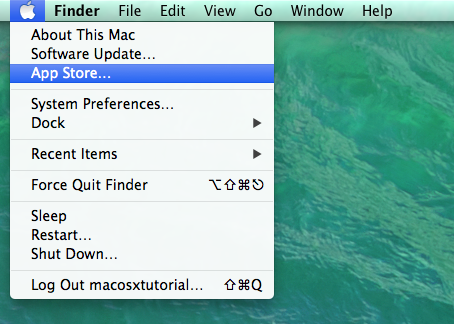
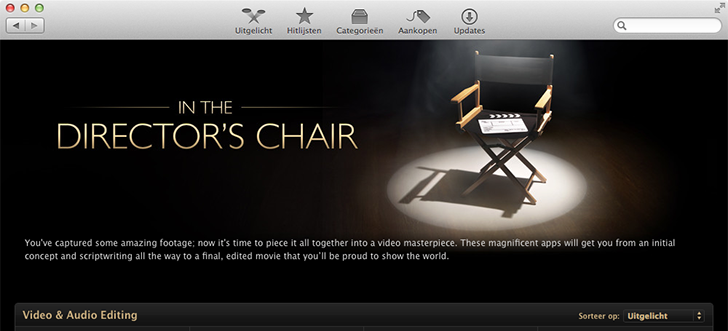
NOTE: buying from the Apple Store requires an internet connection
Other sources
Not all developers sell their software at the Apple Store. A good source to get your software is Macupdate.com. A lot of it is freeware (for free) or cheap (shareware).
WARNING
Be careful to get your software through sources like Usenet / Bittorrent.
You'll never know if the software is working properly. It could contain Malware. More about Malware in the Security Chapter.
Be careful to get your software through sources like Usenet / Bittorrent.
You'll never know if the software is working properly. It could contain Malware. More about Malware in the Security Chapter.
Install or copy?
Many programs do not need to be installed, just copied. Just drag them into the appropriate folder on your hard drive. Sometimes programs do need to be installed. This means that the program has to add more items to your Mac at different places. You'll see the word 'installer' or '.pkg' in the name of the program.
NOTE: Keep your administrator password at hand!
Packages
Some programs are packaged (.dmg) and when unpacked (double click) they become a virtual hard disk on your desktop:
This virtual disk works like a real one It appears on your Desktop and in the Sidebar. After using, you just eject these disks or drag & drop them into the trash.
WARNING
Watch your System version!
See to it that your software is suitable for Mac OS X 10.9 Mavericks. Software from App Store is always OK. They know exactly what your Mac is using as an operating system.
Watch your System version!
See to it that your software is suitable for Mac OS X 10.9 Mavericks. Software from App Store is always OK. They know exactly what your Mac is using as an operating system.
How do I know what operating system my Mac has?
Go to the Apple Menu and select 'About this Mac'L:

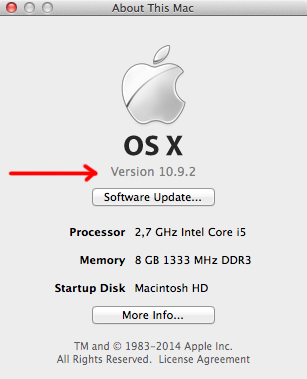
An example of downloading and installing software: the App Store
MacMiep loves to save money, so we'll download a free program as example. We'll use MacTracker, a program that shows you all the Mac's that were ever made and tells you all about their specifications.

Use the search field to look for the program you want.

Click the 'Install App' button to get the program.
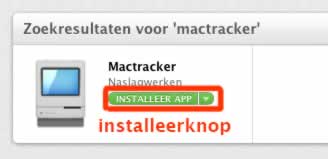
You won't get far without your Apple ID, even with free software....
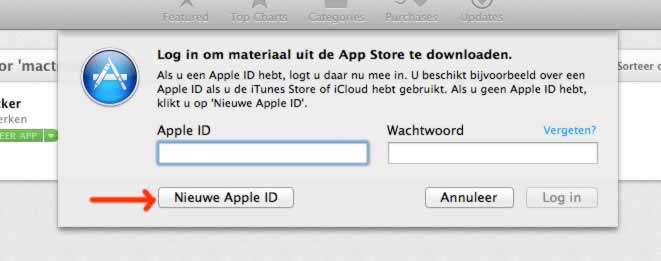
NOTE: Don't you have one yet, choose"New Apple ID"
Depending on the quality of your internet connection the program will appear sooner or later. You can watch the progress of this in Launchpad:
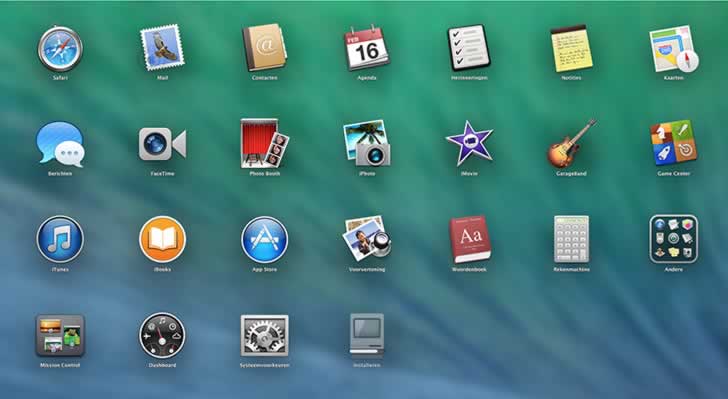
And there it is, in the Applications folder:
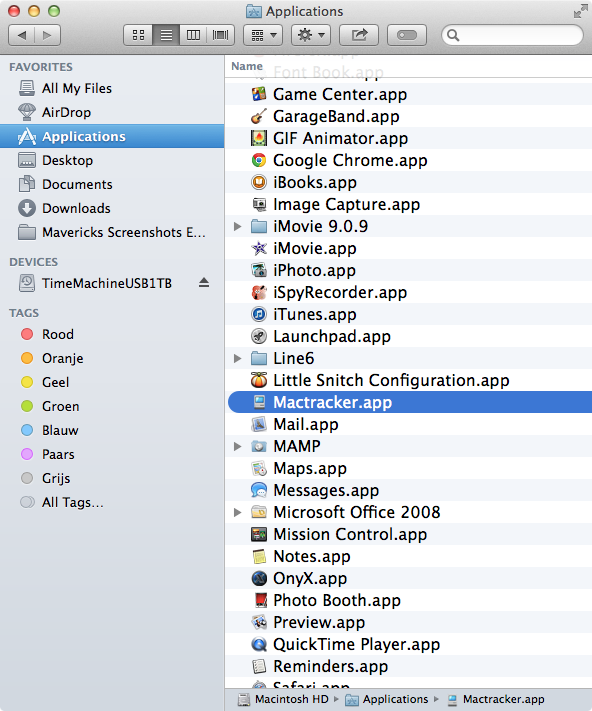
Now you can see the whole history of the Apple Macintosh!
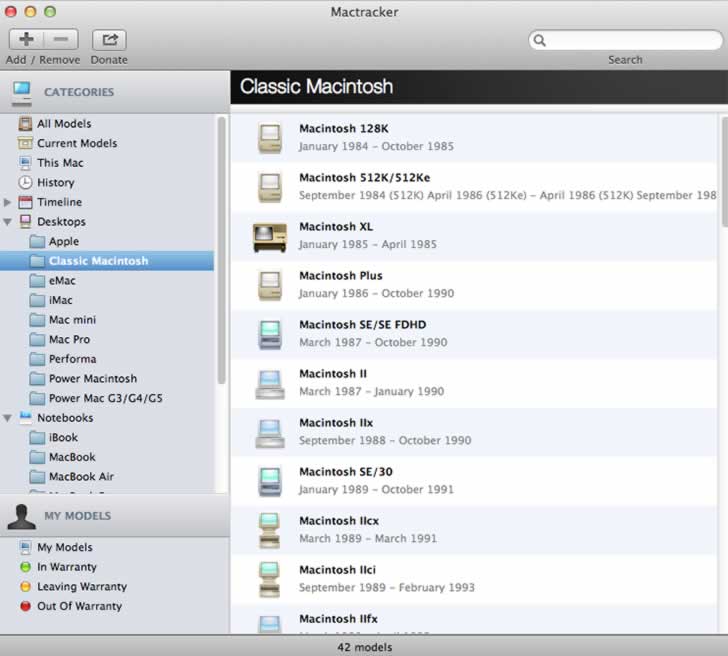
NOTE: If you wish, you can throw the new program in the Dock or even in the Side Bar. Choose what you like best. There are more roads to Rome on a Mac.
An example: downloading and installing without the App Store: Google Chrome
1. download the program from the Google-website.
You'll find it as a .dmg in your Downloads folder:
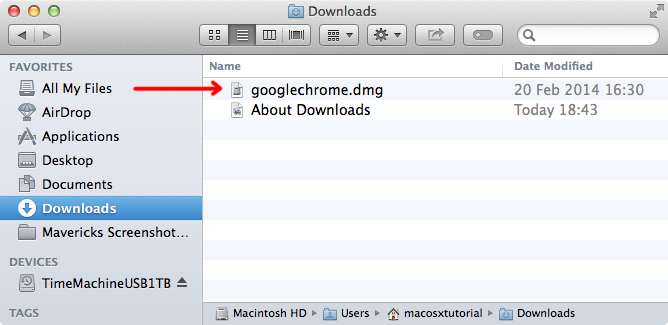
2. Double-click on the .dmg to open it.
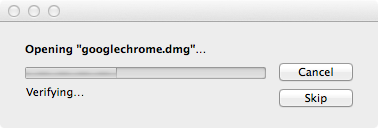
A virtual disc will appear in the Side Bar at DEVICES:

3. The program's on this disk. Drag & drop the program into your own 'Applications' folder:


4. Now Chrome appears in the Applications folder:
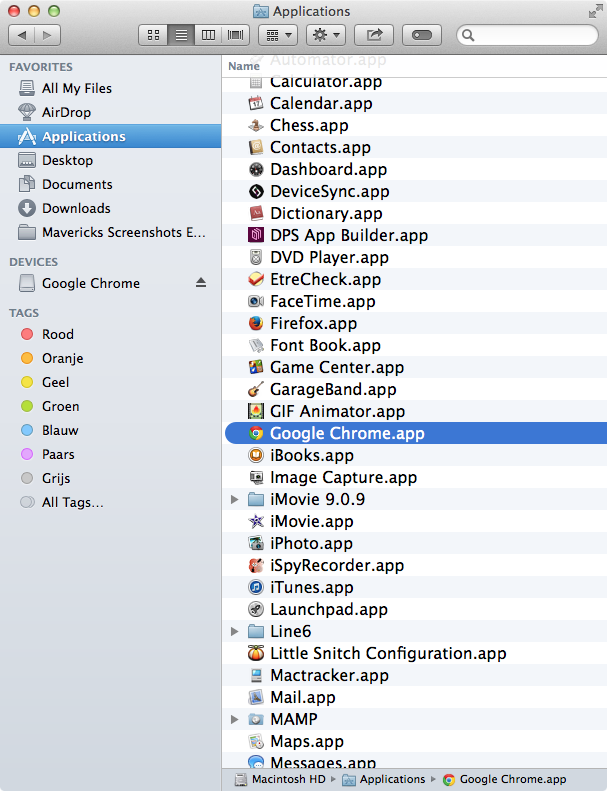
Finished!
NOTE: The virtual disc you used can be drag & dropped into the trash, you don't need it anymore
Start up an App
Double-click the program to start it up.
Put your new program in the Dock
Don't forget to drag and drop your new program into the Dock!
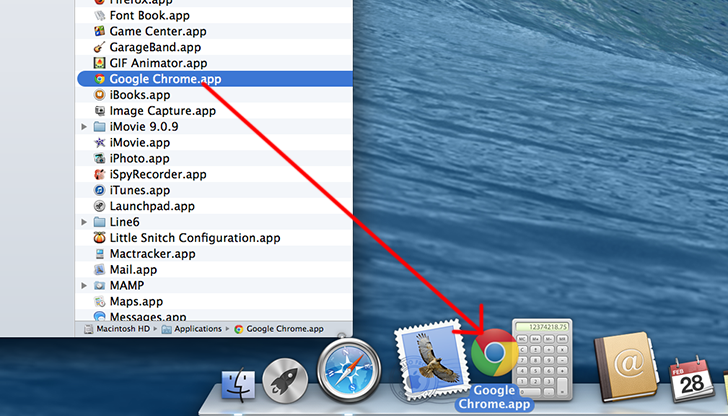
Open at login
Are you planning to use Chrome a lot? Right click on it's dock icon for a menu and choose 'Open at login'.
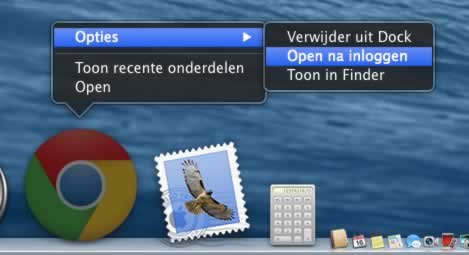
Warning after downloading software
Did you download a program from the internet, like we just did with Chrome? The first time you'll start that program you'll get a message:
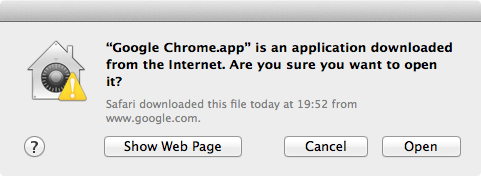
This is a security measure to prevent you from downloading something you didn't want.
Installers
Working with installers is easy. Double click the installer icon and follow the instructions on screen. MacMiep took the Adobe's Flash Player as an example. Only to find at www.Adobe.com.
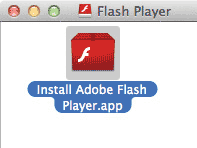
A warning to prevent downloading programs by accident:
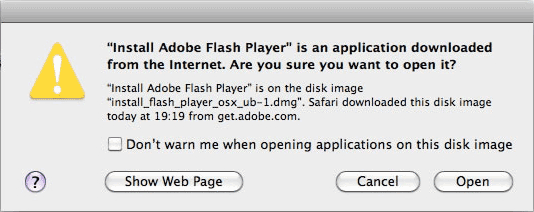
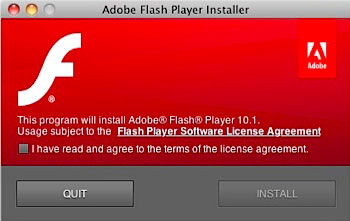
Keep your Administrator password at hand!

NOTE: The installer ask you to quit all your internet browser programs. This is normal.
NOTE: You still need Flash to surf the internet properly. Unfortunately, Flash has a bad name regarding security. It has it's safety updates at a regular basis. More about this in the Security chapter.
Restart
Some software has to add things deeply in your operating system. In case after installation the installer asks for a Restart, do this immediately.
Updates
Software developers try to make their products better and better. Updates you can find in the App Store at Updates.
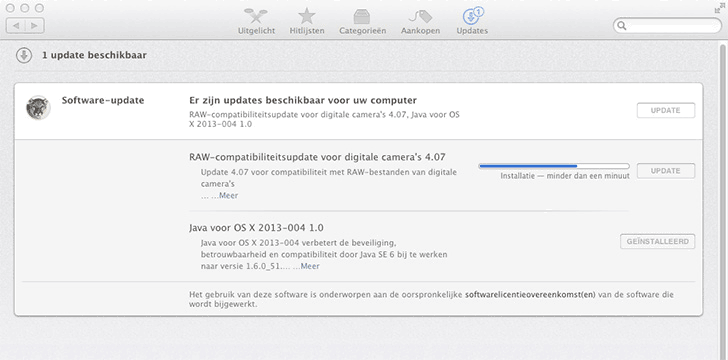
Software that can't be found in the App store has it's own method of updating. Mostly you get a notice that an update has appeared. You can also check for updates yourself. Here I check it in my Dutch version of Excel (MS Office).

SWITCH-TIP
Dot EXE
In Windows a program has the word .EXE (‘executabele’) behind it's name.You'll never find that on a Mac, unless you decide to install Windows, off course. More about this in the Switching chapter.
Dot EXE
In Windows a program has the word .EXE (‘executabele’) behind it's name.You'll never find that on a Mac, unless you decide to install Windows, off course. More about this in the Switching chapter.
TIP
There's no program available that can open my file
You have a file, but no program that can open it.

There's a solution. Right-click on the file and choose 'Open with => App Store'. Your Mac will now search for suitable programs in the App Store.
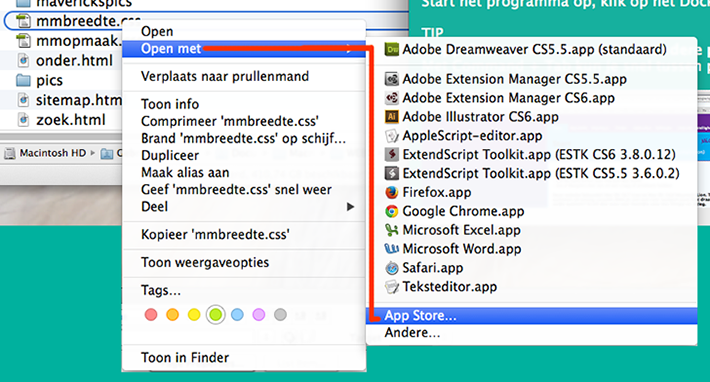
TIP
Copy something from one program to another
You can use 'Copy' and 'Paste' from the 'Edit' menu (Command C, Command V). But did you know you can drag and drop between different programs? It depends on the program and the file, but you can always try.
TIP
Fast switching between programs
Use the shortcut: Command-Tab .
Trackpad-users can sweep with three fingers.
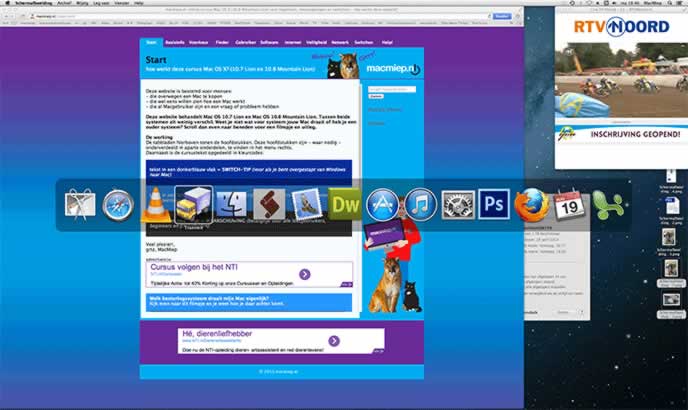
There's no program available that can open my file
You have a file, but no program that can open it.

There's a solution. Right-click on the file and choose 'Open with => App Store'. Your Mac will now search for suitable programs in the App Store.

TIP
Copy something from one program to another
You can use 'Copy' and 'Paste' from the 'Edit' menu (Command C, Command V). But did you know you can drag and drop between different programs? It depends on the program and the file, but you can always try.
TIP
Fast switching between programs
Use the shortcut: Command-Tab .
Trackpad-users can sweep with three fingers.

Installing a printer
There are a lot of printer drivers present in Mac OS X. Go to Printers & Scanners at the System Preferences. Click the + symbol to add a new printer.
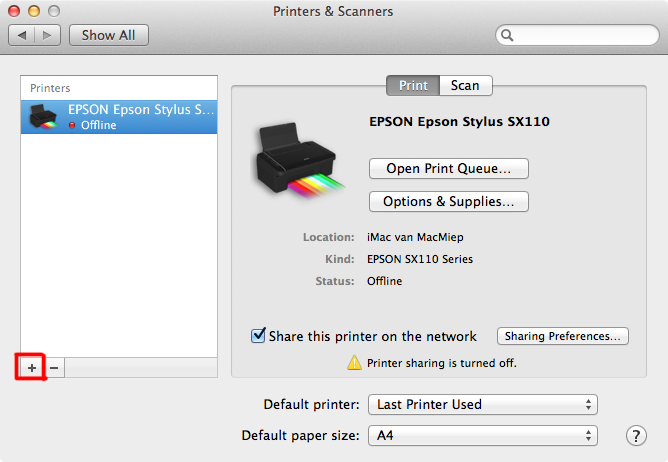
Choose the right kind of printer in the Add window and click the Add button.
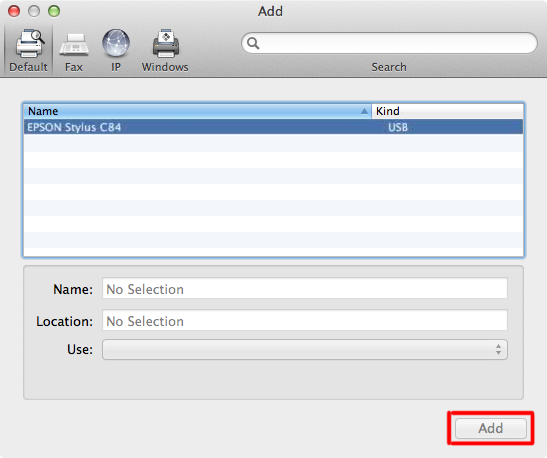
NOTE: In case your printer does not appear in the list, you'll need to install its driver software. Otherwise, visit the manufacturers website for the install software.
How do I print a document?
Printing can be found at the File menu as Print...
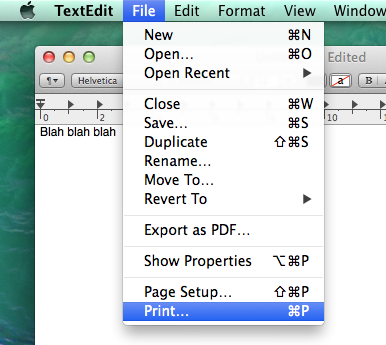
TIP
Make universal PDF documents.
For example, you made a document you want to email somebody. However, that person doesn't have the program the document's made in. No problem at all, you can use the 'Print' command to make a PDF-file. PDF (Portable Document File) is such a common format, almost every computer can read it.
What to do
Open your document and choose 'Print'. Please select "Save as PDF..." instead of "Print".
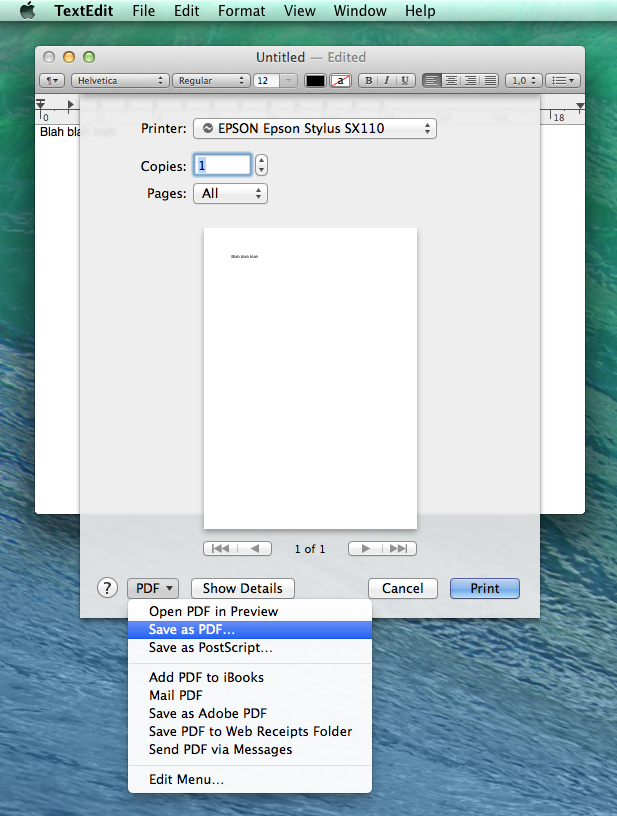
Burning CD's or DVD's
The moment you put an empty cd (or DVD) in the player, Finder will react with the following:
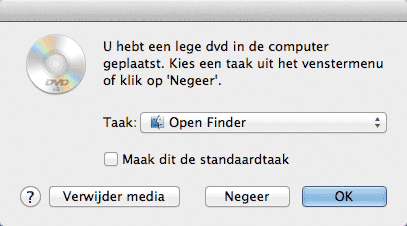
When you choose 'Open Finder', a cd-icon will appear on the Desktop in the Navigation bar.

You can drag and drop your data on it:
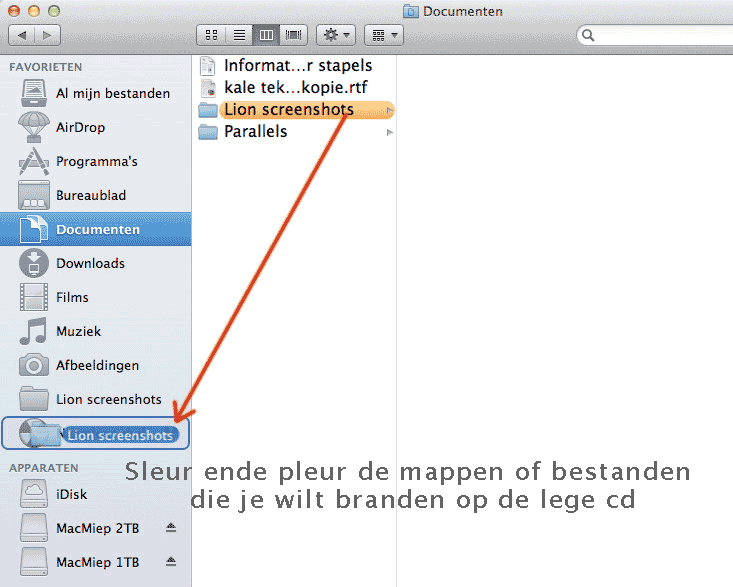
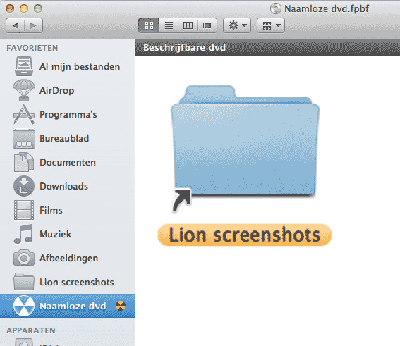
If you want to burn the cd, just click the nuclear icon or drag & drop it into the Trash: Finder will then ask you if you want to burn that cd.
icon or drag & drop it into the Trash: Finder will then ask you if you want to burn that cd.
System preferences for cd’s en dvd’s
In System prefs=> Cd’s & dvd’s you can find the preferences for handling full or empty disks.
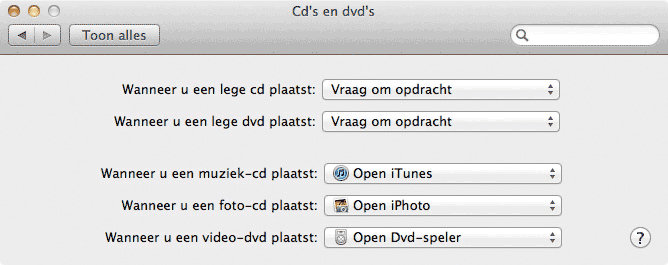
NOTE: Excellent third party software for burning cd's is for example Toast Titanium, made by Roxio. You can use this along side the standard software. It is also possible to burn a cd directly from the program you're working in. Like iTunes for music, iPhoto for photo's and iDVD for movies. Choosing the 'burn' command will automatically open the cd-tray and make the Mac ask for an empty disc.
Make universal PDF documents.
For example, you made a document you want to email somebody. However, that person doesn't have the program the document's made in. No problem at all, you can use the 'Print' command to make a PDF-file. PDF (Portable Document File) is such a common format, almost every computer can read it.
What to do
Open your document and choose 'Print'. Please select "Save as PDF..." instead of "Print".

Burning CD's or DVD's
The moment you put an empty cd (or DVD) in the player, Finder will react with the following:

When you choose 'Open Finder', a cd-icon will appear on the Desktop in the Navigation bar.

You can drag and drop your data on it:


If you want to burn the cd, just click the nuclear
 icon or drag & drop it into the Trash: Finder will then ask you if you want to burn that cd.
icon or drag & drop it into the Trash: Finder will then ask you if you want to burn that cd. System preferences for cd’s en dvd’s
In System prefs=> Cd’s & dvd’s you can find the preferences for handling full or empty disks.

NOTE: Excellent third party software for burning cd's is for example Toast Titanium, made by Roxio. You can use this along side the standard software. It is also possible to burn a cd directly from the program you're working in. Like iTunes for music, iPhoto for photo's and iDVD for movies. Choosing the 'burn' command will automatically open the cd-tray and make the Mac ask for an empty disc.
Spotlight: fast searching
'Search and You will find' is really true on a Mac. The search machine finds in real time file names and file content as you type. Just click the enlarging glass on the upper right of your screen and type:

Use it!!
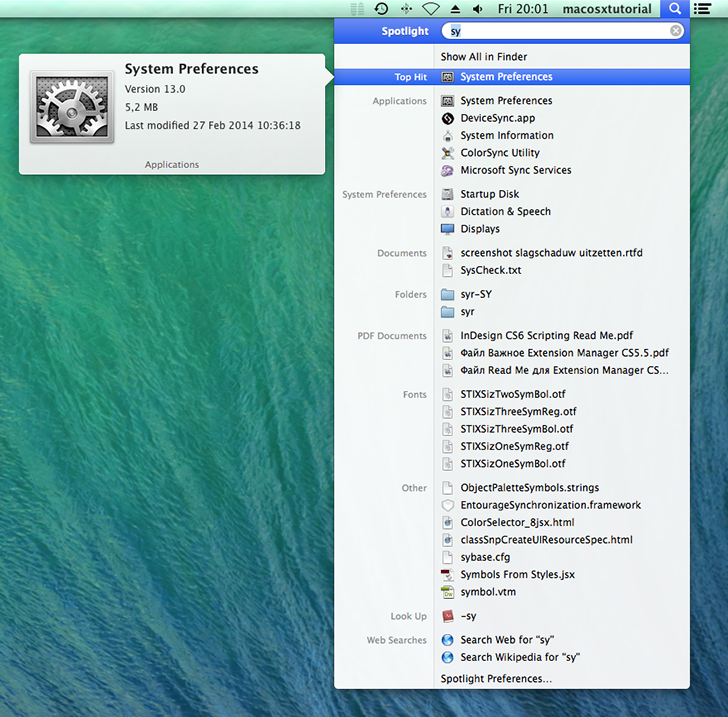
Search in a Finder Window
It is also possible to search in all Finder Windows:
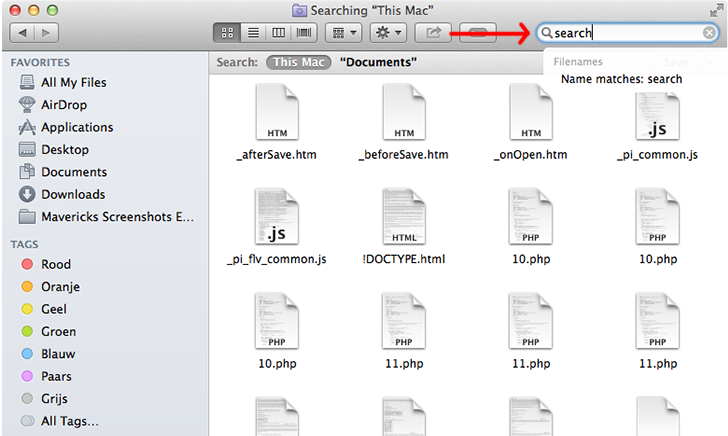
Shortcut forSpotlight:
Command + Space Bar
TIP
Where is Spotlight allowed to search?
You can find this in System Preferences => Spotlight at 'Privacy':

TIP
Use the Google search engine
You can use the Google search engine directly from the Finder. Right click on a selected word and choose 'Search with Google':
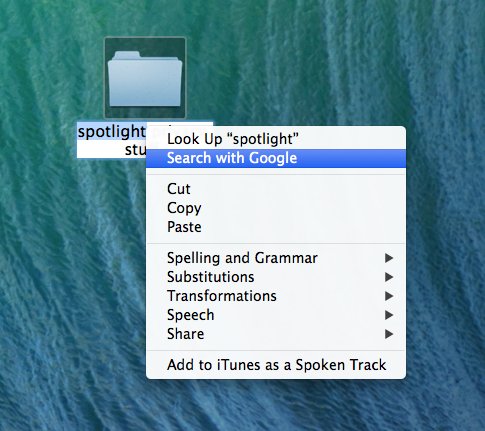
Safari will open automatically and search for the word. This feature also works in other programs, like Texteditor:

Dictionary and Wikipedia
When you choose 'Look up .....' then your Mac will automatically contact online Wikipedia encyclopedia and a dictionary:

The result is a pop up with the explanation of the word:
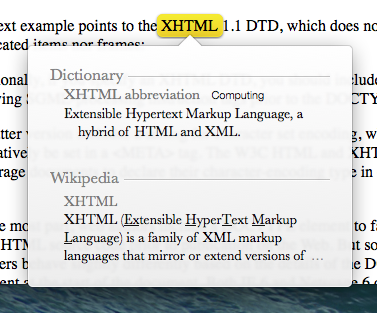
Where is Spotlight allowed to search?
You can find this in System Preferences => Spotlight at 'Privacy':

TIP
Use the Google search engine
You can use the Google search engine directly from the Finder. Right click on a selected word and choose 'Search with Google':

Safari will open automatically and search for the word. This feature also works in other programs, like Texteditor:

Dictionary and Wikipedia
When you choose 'Look up .....' then your Mac will automatically contact online Wikipedia encyclopedia and a dictionary:

The result is a pop up with the explanation of the word:

Using special characters
Option + e = accent aigu
Option + ` = accent grave
Option + u = trema
Option + i = accent circonflexe
Option + 2 = Euro €
How does this work?
For example: to get an á, type the key combination option + e. Nothing will happen yet, but the / will appear when you type the a next. So the accent only appears after you gave the option + e command and then type the character that needs the accent, in this case the letter a.
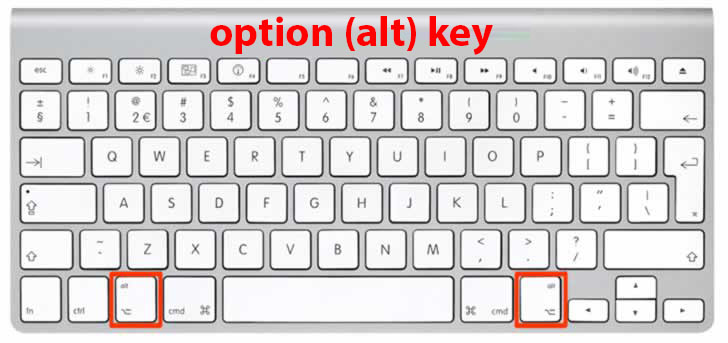
Another way to get a special character
You can also hold the key of character a bit longer. A little pop-up appears. Use your mouse to choose the proper accent.
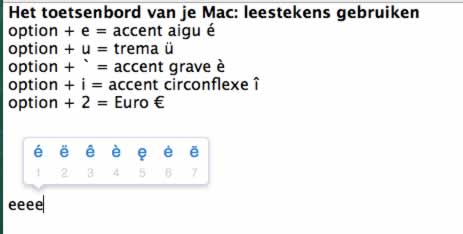
Saving documents: the ins and outs
When you made a document in a program, for example Text-editor, mostly you'd like to save it.
You can find the 'Save' command at the File Menu:

Example of saving a document
Let's save a text-file from the TextEdit program. This is a little program, it comes with your Mac and can open and save Word (.doc) files:

Use the Finder structure during saving documents
Use the blue square to pull down the Save window. You'll find the same structure as in the Finder, including the Side Bar. It's also possible to choose the List or Column:
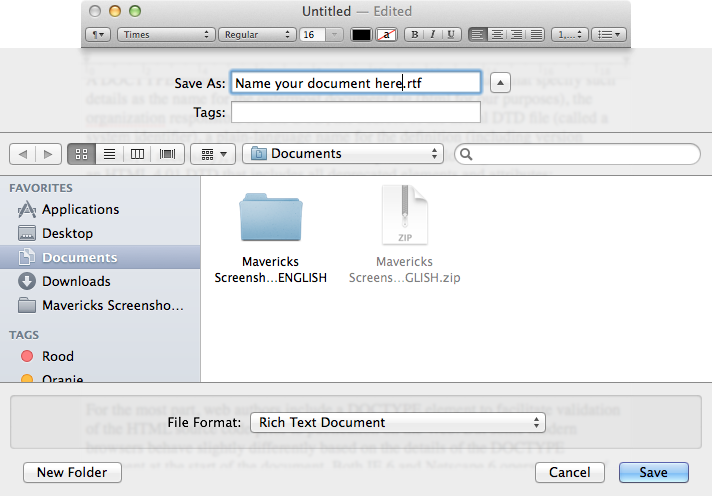
The difference between Save and Save As
'Save As' means that the document gets a totally new name. 'Save' means the document will be saved under the same name and will be overwritten. Mind this!
Save As..
Press the Option key and go to the File menu. An extra 'Save As...' will appear:
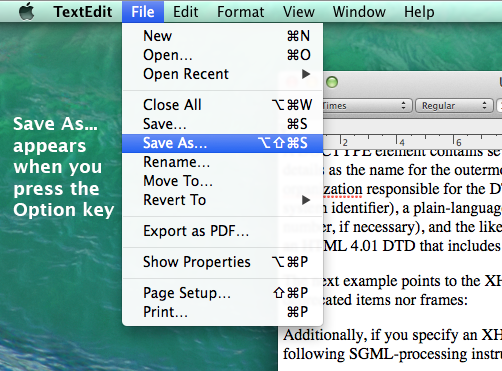
TIP
Utility programs
Here's a list of all Utilities, you can find their folder in the Applications folder:
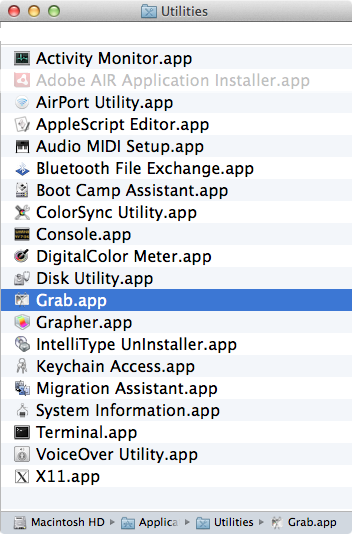
Activity-monitor - see here how your programs and data affect the processor and the hard drive
Airport Admin Utility - configure your Airport network (Apple's own Wi-Fi base station)
AppleScript-editor - AppleScript is a program language for controlling your Mac. For advanced users
Audio MIDI Setup - configure your audio input and midi devices
Bluetooth File Exchange - configures the Bluetooth system
Boot Camp-assistant - Helps you installing Windows on your Mac. More about this in the Switching chapter.
Colorsync Utility - calibrate your monitor and graphical designs (important to desktop publishers)
Console - here you can read all system and program logs
Digital-Color Meter - move your mouse around the screen to find out the Red Green and Blue configuration of the color it's moving on
Disc Utility - format, test, restore and partition hard drives and USB sticks
Grab - Make a screenshot. Shortcut: Command-Shift-3

Grapher - does math and makes graphic representations
Keychain Access - stores your passwords
Migration Assistant - helps import your old data when you buy a new Mac
System Information - all the information about your Mac you need (memory, cards, system, programs)
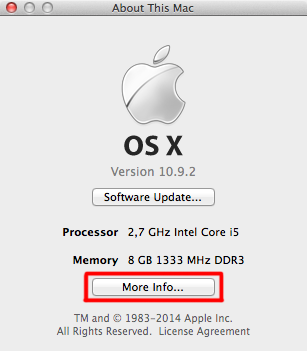 }
}
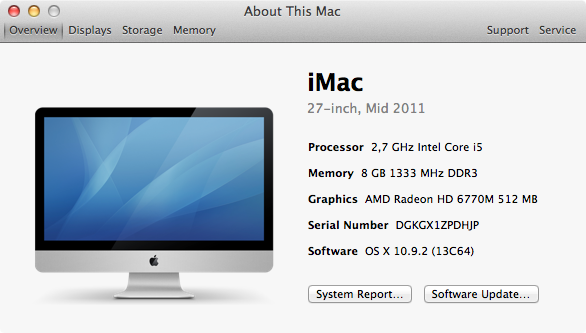
Terminal - use text commands to control your Mac (for the Unix geeks among us)
VoiceOver Utility - command your Mac with your voice
X11 - another graphic representation of the operating system (for the Unix geeks among us)
Utility programs
Here's a list of all Utilities, you can find their folder in the Applications folder:

Activity-monitor - see here how your programs and data affect the processor and the hard drive
Airport Admin Utility - configure your Airport network (Apple's own Wi-Fi base station)
AppleScript-editor - AppleScript is a program language for controlling your Mac. For advanced users
Audio MIDI Setup - configure your audio input and midi devices
Bluetooth File Exchange - configures the Bluetooth system
Boot Camp-assistant - Helps you installing Windows on your Mac. More about this in the Switching chapter.
Colorsync Utility - calibrate your monitor and graphical designs (important to desktop publishers)
Console - here you can read all system and program logs
Digital-Color Meter - move your mouse around the screen to find out the Red Green and Blue configuration of the color it's moving on
Disc Utility - format, test, restore and partition hard drives and USB sticks
Grab - Make a screenshot. Shortcut: Command-Shift-3

Grapher - does math and makes graphic representations
Keychain Access - stores your passwords
Migration Assistant - helps import your old data when you buy a new Mac
System Information - all the information about your Mac you need (memory, cards, system, programs)
 }
}
Terminal - use text commands to control your Mac (for the Unix geeks among us)
VoiceOver Utility - command your Mac with your voice
X11 - another graphic representation of the operating system (for the Unix geeks among us)
Must-have software
A consumer Mac comes with very nice software, but there are some apps you can't live without as a Mac user:
Flash Player: used a lot to play animations and movies (YouTube!) on the web
VLC: Video LAN Client, plays everything from music to movies
Flip4Mac: a plug-in that makes you able to see and hear files in Windows Media format
Silverlight: a plug-in that's used on the web to play movies
NOTE: all for free!
Download for free Arcade Games APK files.
Disclaimer: MacMiep is independent. This means she writes what she wants, based on 20+ years of Mac-experience. She doesn't get paid for stories (positive or negative) on this website.